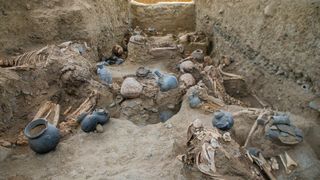
15th-century Chan Chan mass grave discovered in Peru
The mass grave held the remains of about 25 people, mostly women who were likely "dedicated to textiles."
 Archaeologists discovered around 25 skeletons in a mass grave in Peru. (Image credit: Peruvian Ministry of Culture)
Archaeologists discovered around 25 skeletons in a mass grave in Peru. (Image credit: Peruvian Ministry of Culture) In the 15th century, a group of elite women in the ancient city of Chan Chan spent their days making textiles while living ... and in death.
Archaeologists recently uncovered a mass grave in the Trujillo province of modern-day Peru that held the remains of about 25 people, mostly women and a couple of children and teenagers, surrounded by textile tools, including needles, spindles and chalk, according to a statement from the Peruvian Ministry of Culture.
Because the women were buried with these items, they were likely "people dedicated to textiles," according to the statement. The women were buried in a seated position, with their legs bent, and most were under age 30.
Related: In photos: Moche treasures hidden in Peru temple
"It is a very specific population, not too young considering the average human life span was 40 years," Jorge Meneses Bartra, an archaeologist who leads the research project, told Andina, a Peruvian news agency. The skeletons were wrapped with a cotton fabric that was then covered with another fabric made from plant tissue.
The number of grave goods found in the grave pit — including dozens of ceramic objects — suggests that the people buried were elite, according to Smithsonian Magazine.
Archaeologists uncovered the mass grave, which stretched 32 feet (10 meters) long and wide, sealed with mud that contained jar fragments, which may have served as a tomb marker, according to the statement.
The ancient city of Chan Chan, which means "resplendent sun" in the Chimú language, was the largest city in pre-Columbian America and the capital of the Chimú Empire, which was known to perform rituals involving human sacrifices, according to the BBC and Britannica. The empire reached its height in the 15th century, before the Incas conquered it around A.D. 1470.
Archaeologists have yet to find any evidence that the human remains in the recently uncovered grave were the result of such sacrifices; in fact, the researchers don't yet know how the people died, Meneses said in the statement.
RELATED CONTENT—Photos: Ancient circular geoglyphs etched into the sand in Peru
—Photos: The amazing mummies of Peru and Egypt
—In photos: Moche treasures hidden in Peru temple
However, the archaeologists do believe that there were two separate mass burials in the same grave. Within the grave, the archaeologists discovered one skeleton that "maintains its anatomical position" and another whose bones were jumbled and exposed to the elements, according to the statement.
This finding suggests that the ancient people buried some of these individuals right after they died and some later on. They likely brought the remains of the second group of people from another burial place, according to the researchers.
"This shows that the Chimu used to relocate and manipulate their deceased," Sinthya Cueva García, director of the Chan Chan Archaeological Complex Special Project's Archaeological Research Program, said in the statement.
Originally published on Live Science.
 Yasemin Saplakoglu Staff Writer
Yasemin Saplakoglu Staff Writer Yasemin is a staff writer at Live Science, covering health, neuroscience and biology. Her work has appeared in Scientific American, Science and the San Jose Mercury News. She has a bachelor's degree in biomedical engineering from the University of Connecticut and a graduate certificate in science communication from the University of California, Santa Cruz.
window._taboola = window._taboola || []; var screenWidth = window.screen.width; function taboola_is_device(device) { if ((! device) || device === null || (typeof device) === 'undefined') return true if (device === 'amp') return false if (device === 'desktop' && screenWidth >= 700) return true if (device === 'mobile' && screenWidth < 700) return true return false } (function(){ var suitableDevice = taboola_is_device("desktop"); var suitablePlacement = !("Mid Article".includes('Mid Article') && "") && !("Mid Article".includes('Mid Article') && window.FUTR && window.FUTR.Kiosq && window.FUTR.Kiosq.hasBarrier); if (suitableDevice && suitablePlacement) { window._taboola.push({ mode: "thumbnails-a-mid", container: "desktop-taboola-mid-article", placement: "Mid Article", target_type: "mix" }); } })(); (function(){ var suitableDevice = taboola_is_device("mobile"); var suitablePlacement = !("Mid Article".includes('Mid Article') && "") && !("Mid Article".includes('Mid Article') && window.FUTR && window.FUTR.Kiosq && window.FUTR.Kiosq.hasBarrier); if (suitableDevice && suitablePlacement) { window._taboola.push({ mode: "thumbnails-a-mid", container: "mobile-taboola-mid-article", placement: "Mid Article", target_type: "mix" }); } })(); (function(){ var suitableDevice = taboola_is_device("desktop"); var suitablePlacement = !("Below Article Thumbnails".includes('Mid Article') && "") && !("Below Article Thumbnails".includes('Mid Article') && window.FUTR && window.FUTR.Kiosq && window.FUTR.Kiosq.hasBarrier); if (suitableDevice && suitablePlacement) { window._taboola.push({ mode: "thumbnails-f", container: "taboola-below-article-thumbnails", placement: "Below Article Thumbnails", target_type: "mix" }); } })(); (function(){ var suitableDevice = taboola_is_device("mobile"); var suitablePlacement = !("Mobile Below Article Thumbnails".includes('Mid Article') && "") && !("Mobile Below Article Thumbnails".includes('Mid Article') && window.FUTR && window.FUTR.Kiosq && window.FUTR.Kiosq.hasBarrier); if (suitableDevice && suitablePlacement) { window._taboola.push({ mode: "thumbnails-g", container: "taboola-mobile-below-article-thumbnails", placement: "Mobile Below Article Thumbnails", target_type: "mix" }); } })(); (function(){ var suitableDevice = taboola_is_device("amp"); var suitablePlacement = !("below-main-column".includes('Mid Article') && "") && !("below-main-column".includes('Mid Article') && window.FUTR && window.FUTR.Kiosq && window.FUTR.Kiosq.hasBarrier); if (suitableDevice && suitablePlacement) { window._taboola.push({ mode: "thumbnails-a", container: "", placement: "below-main-column", target_type: "" }); } })(); (function(){ var delay = 0; window.setTimeout(function() { window._taboola.push({flush: true}); }, delay); })();Introducing Jobbguru: Your Gateway to Career Success
The ultimate job platform is designed to connect job seekers with their dream career opportunities. Whether you're a recent graduate, a seasoned professional, or someone seeking a career change, Jobbguru provides you with the tools and resources to navigate the job market with ease.
Take the next step in your career with Jobbguru:
Don't let the perfect job opportunity pass you by. Join Jobbguru today and unlock a world of career possibilities. Start your journey towards professional success and discover your dream job with Jobbguru.
Originally posted on: https://www.livescience.com/peru-15th-century-mass-grave-chan-chan